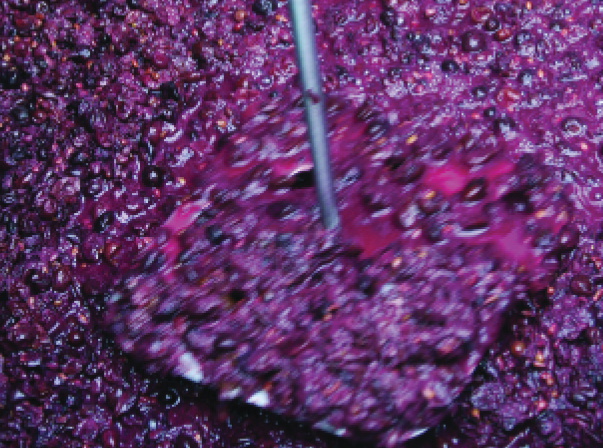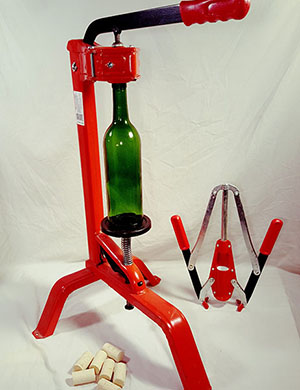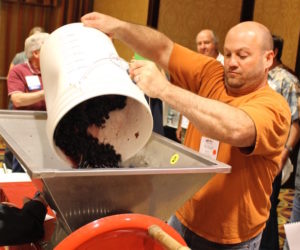
Maceration is the process in red winemaking of letting the crushed grape solids soak in the juice. It is during maceration that key compounds are extracted from the grape juice and solids, giving red wine its body, flavors and color. These compounds are known as phenols and mainly comprise of tannins, color pigments and flavor compounds. The concentration of phenols in wine depends on maceration techniques, such as cold soaking and cap management.
Effects of Maceration
It is during maceration that red wines acquire part of their structure. The amount of phenols extracted during maceration depends on a number of factors that will need to be managed and controlled. These include the maceration period and temperature and cap management (pumping-over and punching-down operations). As a general rule of thumb, the longer the juice and grape solids are in contact, the more tannin and color will be extracted, and the more full-bodied and colored a red wine will be. The amount of phenol extraction is high in the early days of maceration and continues, albeit at a slower rate, in the final days. Color extraction, on the other hand, happens within the first few days to one week and then subsides. There is very little color extraction after the tenth day or so.
For maximum phenol extraction, you want to prolong the maceration period as much as possible until little or no extraction occurs. The challenge is to retard and slow down fermentation, which would otherwise greatly reduce the maceration period and the level of extraction. The fermentation temperature will rise rapidly up to 90 °F (32 °C) or more, if not controlled, and will cause a rapid fermentation or may cause a stuck fermentation. The solution is cold soak pre-fermentation.
By dropping the temperature of the juice and grape solids down to 46 °F (8 °C) or lower, you effectively prolong maceration and inhibit fermentation. For a full-bodied, deep-colored red wine using grapes which have been cold-shipped to your house, cold soak the juice and grape solids up to two weeks before initiating fermentation by placing sealed freezer bags full of ice into the juice. When using freshly picked grapes, you will need to store the grapes in a cooler — not a practical solution for most home winemakers — or use the freezer-bag method. Be sure to stir the juice and solids during cold soak to distribute the temperature evenly, and add approximately 50 mg/L of sulfite to prevent volatile acidity from forming. Punch down the grapes at least twice a day to prevent microbial spoilage. When ready to start fermentation, inoculate the must with yeast.
During maceration, keep the fermenter covered and properly sealed with a tarp (water-proofed canvas) to prevent bugs from invading the sweet juice. Fruit flies, in particular, can introduce microorganisms like Acetobacter — which causes wine to turn into vinegar — to your wine. Carbon dioxide (CO2) gas produced during fermentation will get trapped between the cap (the mass of grape solids above the juice) and the tarpaulin, thereby protecting the juice from oxidation and microbial spoilage. During cold soaking, when no gas is produced, inject CO2 gas under the tarp from a tank to protect the must from oxidation. Inject enough gas to form a layer above the must, and quickly tie down the tarp to prevent gas from escaping.
During fermentation, the grape skins will form a cap and rise to the top of the must. This is known as “cap rise.” To prevent spoilage and to maximize phenol extraction, punch down the cap three times a day. Separately or in addition to punching the cap, pump the juice over the cap.
Pumping over involves using an electric pump to recirculate juice from the bottom of the fermenter to the top (over the grape solids). This has the added benefit of dissipating some heat from the fermenting juice. Don’t overdo it to avoid oxidizing the wine. It only takes about 20 seconds for 53 gallons (200 L).
Consult your retailer about choosing the right pump. Not just any pump will do, since it has to be able to displace the grape solids that enter it. A one-horsepower, positive-displacement impeller pump with 11⁄2-inch tubing is recommended, as a minimum. If you do not have a pump, collect some juice with a bucket from the bottom of the fermenter and pour it over the cap. A fermenter equipped with a spout will prove practical.
As you will be removing the tarp frequently during punching of the cap and pumping over, the protective CO2 gas will escape. During the vigorous phase of fermentation, sufficient gas is produced to provide adequate protection. When fermentation subsides, you may need to inject CO2 gas under the tarpaulin from a tank.
When fermentation is complete and the Brix level has reached 0°, an additional week or 10 days of post-ferment maceration will be beneficial in softening the tannins. Closely monitor the wine during this phase to avoid unpleasant results such as microbial spoilage. Extended maceration is not recommended for high-pH wines, since these do not benefit as much from long extraction and are more prone to microbial spoilage.
To maximize the benefits of phenol extraction, choose a fermenter that provides an adequate ratio of juice surface to volume. A greater surface ratio allows more juice to be in contact with the grape solids, thereby increasing extraction. A 350-liter food-grade plastic fermenter is a good choice. It can hold up to 18 36-pound (16.3-kg) cases of grapes. Be sure to account for volume from the rising of the cap when choosing the size of a primary fermenter. Choose one with some extra space.
When high color and tannin extractions are desired without cold soak or extended maceration, fermentation can be carried out at the high end of the recommended temperature range of 72–86 °F (22–30 °C). This method can be used with low-tannin grapes where extended maceration provides no benefit. It also has the advantage of minimizing the risk of oxidation and microbial spoilage since the duration of must exposure to air is reduced. Many great wines are made using high-temperature fermentations.
Another trick to increase the yield of juice from maceration: Add a small amount of pectic enzymes at crushing time and ferment at the high end of the temperature range. Pectic enzymes are most effective above 80 °F (27 °C). In powder form, pectic enzymes are added at a rate of up to 1⁄2 ounce per gallon (4 g/hL). The powder should be dissolved in a small amount of cool water first. In liquid form, add up to 3 drops of pectic enzymes per gallon (4 L) of wine. To avoid extraction of overly harsh tannins don’t use pectic enzymes if macerating with stems.
White wines do not tend to benefit from maceration since no color extraction is required and tannins are not desirable. Some commercial winemakers macerate their crushed white grapes for up to 24 hours to give their wines a little more structure and color, but the practice is not recommended for home winemakers due to the increased risk of oxidation and phenol over-extraction.






